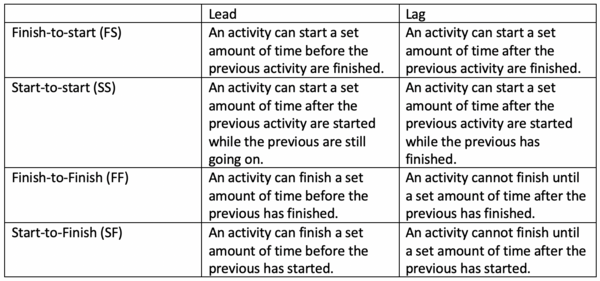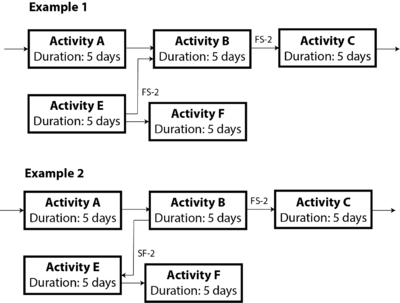Lag & Lead
(→Limitations) |
|||
| Line 67: | Line 67: | ||
| − | == | + | == Downside to Lag and Lead == |
| − | Lag and Lead is not a tool but a technique, there are limitation. Lag and Lead are more useful if use together with another tool, this could be the network diagram or the critical path methods as suggested in the article. There are also other scheduling methods where Lag and Lead are used. Another limitation can be that Lag and Lead can be hard to identify at the beginning of the project and therefore they have to be adjusted during the project. It can also be hard for the project manager alone to identify all the Lag and Lead, that means that if the project manager alone is reasonable for the Lag and Lead the estimate will be more off than if the estimates are made with the project management team and with input from the project team. Activities can have Lag and Lead with different types of relationships, however as stated the Finish-to-start is the most used one. A Start-to-finish relationship can in most cases be change to a finish-to-start as the defining activity is swapped. This is not a limitation, but this has caused confusion and lead some sources online to say that two activities with a lead can only have a Finish-to-start relationship. However, it depends on which activities are depending on what other activities. On figure 7 two examples of the dependency can be seen. If activity B is more depend on activity E than the other way around the relationship will be Finish-to-start if the activities are sequences as shown on figure 7(Example 1). If activity E is more depended on activity B the relationship will be Start-to-Finish if the sequences are as shown on figure 7(Example 2). There a project management team should keep an overview of which activities are depending on what. | + | Lag and Lead is not a tool but a technique, therefor there are very little are limitation. Lag and Lead are more useful if use together with another tool, this could be the network diagram or the critical path methods as suggested in the article. There are also other scheduling methods where Lag and Lead are used. Another limitation can be that Lag and Lead can be hard to identify at the beginning of the project and therefore they have to be adjusted during the project. It can also be hard for the project manager alone to identify all the Lag and Lead, that means that if the project manager alone is reasonable for the Lag and Lead the estimate will be more off than if the estimates are made with the project management team and with input from the project team. Activities can have Lag and Lead with different types of relationships, however as stated the Finish-to-start is the most used one. A Start-to-finish relationship can in most cases be change to a finish-to-start as the defining activity is swapped. This is not a limitation, but this has caused confusion and lead some sources online to say that two activities with a lead can only have a Finish-to-start relationship. However, it depends on which activities are depending on what other activities. On figure 7 two examples of the dependency can be seen. If activity B is more depend on activity E than the other way around the relationship will be Finish-to-start if the activities are sequences as shown on figure 7(Example 1). If activity E is more depended on activity B the relationship will be Start-to-Finish if the sequences are as shown on figure 7(Example 2). There a project management team should keep an overview of which activities are depending on what. |
[[File:Lead_relationship.png|thumb|center|400px|Figure 7. Examples of two types of Lead relationships in a sequence.]] | [[File:Lead_relationship.png|thumb|center|400px|Figure 7. Examples of two types of Lead relationships in a sequence.]] | ||
== References == | == References == | ||
<references /> | <references /> | ||
Revision as of 12:46, 28 February 2021
Developed by Helene Waldmann Jørgensen
Contents |
Abstract
A project manager oversees that the project finishes on time and therefore the project manager must keep the project on schedule. A heavy project delay is often seen as a project management failure, therefore keeping a project on schedule is important for the success of the project management team. This article will present the concept of Lag and Lead and how a project manager can use this actively to help scheduling and adjusting the scheduling during the project. Lag and Lead are used in the process of sequencing activities before the project starts. Task and activities are scheduled to take place at the same time or after each other. Using the concept of Lag and Lead task and activities can be scheduled to take place with the right overlap or time in between. A lead means an activity takes place while the previous is still going on and a lag means that there is a pause before an activity start after the previous have finish. Lag and lead are used in other different specific scheduling tools for example Critical Path Method and Network planning. Having an overview of the Lag and Lead needed between each task and activity means that project manager can optimize the schedule and know where to gain lost time to finish the project on time. There are some limitations with Lag and Lead as it is not a tool but rather a technique that is used in different tools.
Importance of Lag and Lead
As a project is only temporary endeavor[1] therefore there is a start and a finish date. In most cases the finish date is decided in the process of planning a project. When the project starts it is the project managers job to keep the project on schedule and avoid any major delays. A project that is done well but not done on time can be viewed as a project management failure, as the project did not fail but the management made mistakes as the project was not done on time. The Prince2 standart states "Plans provide the backbone of the management information required for any project; without a plan there can be no control."[2] This states the importance of a plan that includes timeframe, what will deliver by who and how. Before the start of a project or in the beginning of the project management team will make a schedule for the project. There are different parts that goes into the making of a schedule. The parts include:
- Planning the Management Schedule[1]
- Defining the activities[1]
- Sequencing Activities[1]
- Estimate Activity Durations[1]
- Develop Schedule[1]
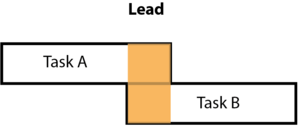
During the project the project management team will control the schedule as well[1] . If the project is part of a program or a portfolio they might have developed a common way of planning a project and the project management should use this common way of planning[2]. Lag and Lead is part of Sequencing Activities. In the process of Sequencing Activities, the relationship between the activities in the project are identified and documented. The benefits from the process are the definition of the logical sequence of work to obtain the greatest efficiency given all the project constrain [1] . All activities in the project should be connected to a least one predecessor and at least one successor expect the first and last activity. Activities should be connected to another activity with an appropriate logical relationship. These logical relationships must be designed so a realistic project schedule can be created. To help create and support a realistic project schedule Lag and Lead are used in between activities. Sequencing Activities will take the list of activities and turn them into a diagram to act as a first step to publish the schedule baseline[1]
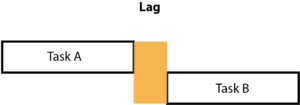
In Project Management: A guide to the Project Management Body of Knowledge lead is defined as “A lead is the amount of time a successor activity can be advanced with respect to a predecessor activity.”[1]. The ISO standard ISO 21500 defines lead as “Attribute applied to a logical relationship to advance the start or end of an activity”[3].. These two definitions are two ways of saying a lead set the amount of time an activity can start before the previous are finished. When using lead the two activities will be done in parallel during the lead time. Figure 1 shows an illustration of lead time.
There are also two definitions of Lag one from Project Management: A guide to the Project Management Body of Knowledge and one from the ISO 21500. The Project Management: A guide to the Project Management Body of Knowledge definition of lag is “A lag is the amount of time a successor activity will be delayed with respect to a predecessor activity.”[1] . The definition in the ISO 21500 of lag is “Attribute applied to a logical relationship to delay the start or end of an activity”[3]. Again, this is two ways of defining the same thing, that Lag means an activity takes place a set amount of time after the previous. Lag should one be applied if there is logical reason for it. Figure 2 shows an illustration of lag time. Lag should not be included in the duration of the activity as no-one needs to work on the activity during the Lag[4].
Making estimated of the Lag and Lead time in the beginning of a project can help a project manager keep the project on schedule and understanding the relationship between activities. Lag and Lead cannot just be used in project management but can also be used in project program management. A project program is a set of related projects subsidiary programs, and program activities that are managed in coordination to obtain benefits this is not obtained if they are all managed individually. A program can also benefit from Lag and Lead, as some projects in the program might benefit from having a lead and some will benefit from having a lead. A project involving the design of a product might overlap with a project involving the manufacturing of this product, this means that these two projects will have a lead. Projects in a program might need lag if one project is about the design and manufacturing plans of a product and another project is about the marketing of this product. Here a lag could be needed so that the marketing is starting before the product is produced and ready to ship. There could be many relations between projects in a program, and the important thing is to know their relation and know when they will benefit from a Lead and when they will benefit from a Lag.
Application of Lag and Lead
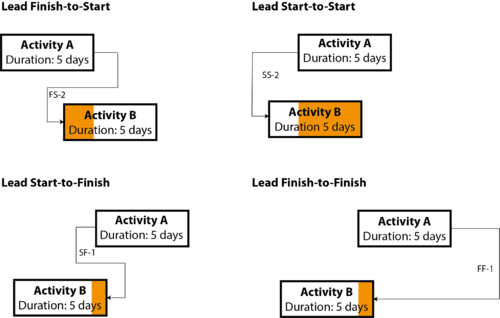
Lead is useful when a task or an activity can start before the previous is complete done. An example of this is when writing a big report, the editing can start before the writing is done. Lag is useful when there need for a break from when a task is done to when the next start, here an example is that concrete underneath the floor need time to dry before the floor are laid on top or that the plaster needs to dry before the wall is painted. Keeping an overview of when a task or an activity can start in relation to the previous mean that the scheduled can be optimized to save time. Lag is used when there is need to wait before the next activity can start and during the waiting no activity is going on. There needs to be a logical reason to have a Lag this could be a predefined need or some strategic goal(source). Unnecessary Lag will delay the project without proper justification.
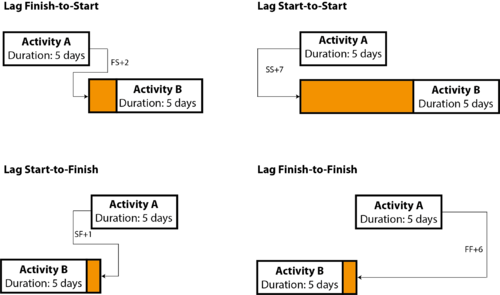
There are four relationships between activities Finish-to-start, Start-to-start, Finish-to-Finish and Start-to-finish. They will normally be shortened to FS, SS, FF, and SF. See table 1 for an explanation of the four types of relationship Lag and Lead. The most used relationship is Finish-to-start[1] . Some articles online on Lag and Lead tells that Lead only can have a Finish-to-start relationship[6] however the Project Management: A guide to the Project Management Body of Knowledge and iZenBrigde states that activities with lead time can have all types of relationships[1] [5] . Figure 3 and 4 show illustrations of the two activities with all four relationship both for Lag and Lead. When using a scheduling software lead is often put as a negative lag, as this is a way of saving and therefore an advantage.
Project Schedule Network Diagram
Lag and Lead is a part of the creation of the Project Schedule Network Diagram also called Project Network Diagram. The network diagram shows the logical relationship between activities. It is produced manually or with a project management software. As the network diagram is a graphical representation of the schedule the Lag and Lead are also added to have the information on when Lag and Lead is used shown graphical.
When using Lag and Lead the project management team determines the dependencies between activities that may require a Lead or a Lag. Using Lag and Lead should not replace schedule logic and the duration estimates made by the teams should not include any Lags and Leads. The team should document the activities and the related assumptions [1]. Figure 5 shows a Project Schedule Network Diagram.

Critical Path Method

After having done the network diagram The Critical Path Method (CPM) can be used to identify the Critical path in a project. When identifying the critical path, the Lag and Lead are used. In the critical path the earliest start and finish day are calculated as well as the latest start and finish day and the float. The float is not to be confused with the Lag and Lead. Float is also known as slack, and it means the time an activity can be push without interfering with the project finish. In the critical path methods, the box shown in figure 6 is filled out for all activities. In order to calculate the critical path, you make a network diagram but with a box like the one shown in figure 4 for each activity. Then on a forward path the early start and finish date is calculated. The first activity starts on day one.
- Early finish day is calculated by: Early start day + duration – 1
- Early start day is calculated by: Early Finish day on the previous activity + Lag/Lead + 1
This is if the relationships are Finish-to-start, if not check out this link. This is done for all activities, if an activity has two predecessors the latter of the two early finish date are used to calculate the early start day for the successor activity. When the early start and finish day has been calculated for all activities the late finish, the late start and the float is calculated on a backwards path. You start with the latest date out of the early finish day.
- Late start day is calculated by: Late Finish day – duration + 1
- Late finish day is calculated by: Late start day on the previous activity - Lag/Lead – 1
- Float is calculated by: Late finish day - Early finish day
The critical path is the longest with the lowest float often zero float [1]. Having this overview of the critical path mean that if an activity is delayed the project manager can easily see if the affects the rest of the project or not. If the delayed activity has a float and the delay is smaller than the delay is has no consequence for the project. However, if the delay is bigger than the float or there is no float then the project will be delayed in action is taken to gain the lost time. If the delayed is bigger than the float the path with the delay will in most cases become the critical path.
Gain lost time
To gain lost time fast tracking or crashing can be done. Fast tracking is when the schedule is compressed by adding a lead or making the lead bigger than the originally intended (PMBOK). Fast tracking is associated with risks, one of the risks is having to rework because as the previous activity finish the content of the activity might have changed. Fast tracking may also lead to higher costs. Fast tracking also only works if it is on the critical path and activities can be done at the same time. If there is a lag between activities fast tracking can be very hard, however it might be a possibility to skip the lag in some cases. An example could be that in the schedule all the walls will be plastered, then have a lag of two days to dry and then all the walls are painted. In this case it might be possible to start painting two days after the first room or wall have been plastered on a wall. Another way to speed up a project is crashing, here more resources are added. Resources could be machinery, more workers, workers working overtime or other things that could make the work in each activity get done faster. Adding resources comes with a higher cost. Crashing again only makes sense if it is on the critical path and where adding resources will reduce the duration of an activity. Crashing may result in a higher risk[1].
Setting the correct Lag and Lead time from the begin will result in a schedule that is used and with less delays. However, during a project there might be a reason to change a lead, as it was not possible to work in parallel as foreseen. There might also be lag that take short or longer, here it is important to know the critical path of the project and know if the wrong estimation will lead to delay of the project. If you experience delay, try to see if you can find a way to increase the lead and reduce the lag. Here you might need to think creative! But by the project manager adjusting the Lag and the Lead during the project lost time can be gained.
Downside to Lag and Lead
Lag and Lead is not a tool but a technique, therefor there are very little are limitation. Lag and Lead are more useful if use together with another tool, this could be the network diagram or the critical path methods as suggested in the article. There are also other scheduling methods where Lag and Lead are used. Another limitation can be that Lag and Lead can be hard to identify at the beginning of the project and therefore they have to be adjusted during the project. It can also be hard for the project manager alone to identify all the Lag and Lead, that means that if the project manager alone is reasonable for the Lag and Lead the estimate will be more off than if the estimates are made with the project management team and with input from the project team. Activities can have Lag and Lead with different types of relationships, however as stated the Finish-to-start is the most used one. A Start-to-finish relationship can in most cases be change to a finish-to-start as the defining activity is swapped. This is not a limitation, but this has caused confusion and lead some sources online to say that two activities with a lead can only have a Finish-to-start relationship. However, it depends on which activities are depending on what other activities. On figure 7 two examples of the dependency can be seen. If activity B is more depend on activity E than the other way around the relationship will be Finish-to-start if the activities are sequences as shown on figure 7(Example 1). If activity E is more depended on activity B the relationship will be Start-to-Finish if the sequences are as shown on figure 7(Example 2). There a project management team should keep an overview of which activities are depending on what.
References
- ↑ 1.00 1.01 1.02 1.03 1.04 1.05 1.06 1.07 1.08 1.09 1.10 1.11 1.12 1.13 1.14 1.15 1.16 1.17 1.18 1.19 Project Management Institute, Inc., Project Management: A Guide to the PROJECT MANAGEMENT BODY OF KNOWLEDGE, (Project Management Institute, Inc. (PMI). 6th Edition), Part 1 chapter 6
- ↑ 2.0 2.1 Nigel Bennett, Robert Buttrick, Phil Stanton, Project Management: "Managing Successful Projects with PRINCE2, (AXELOS Limited). 6th Edition 2017, Chapter 9), Part 1 chapter 6
- ↑ 3.0 3.1 Dansk Standard, DS/ISO 2500, Dansk standard 2nd edition)
- ↑ Project-Management.info, "What Are Leads and Lags in Project Management?", https://project-management.info/leads-and-lags//
- ↑ 5.0 5.1 5.2 iZenBrigde, "What is Lead and Lag", https://www.izenbridge.com/blog/what-is-lead-lag/
- ↑ Invensis learning, "Leads and Lags in Project: How to Apply?",https://www.invensislearning.com/articles/pmp/leads-and-lags-in-project
